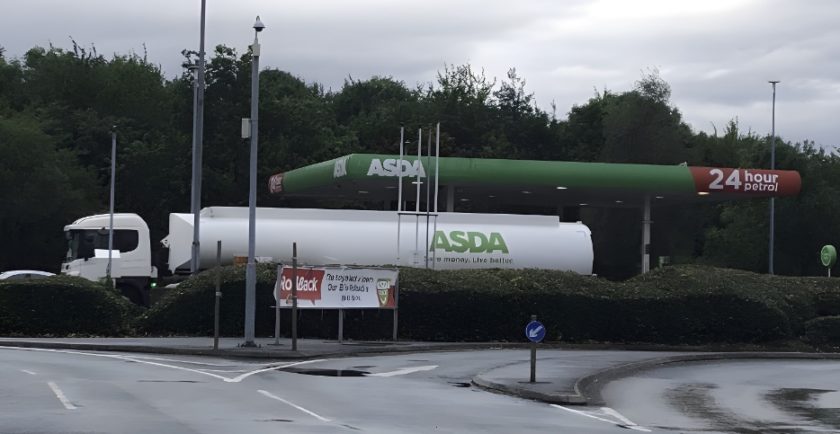Increased supermarket profit margins led to drivers paying extra 6p per litre for fuel last year

An investigation by the Competition and Markets Authority (CMA) into the UK’s fuel market has uncovered that elevated supermarket profit margins led to drivers paying an extra 6p per litre for fuel in 2022.
In its final report, the CMA has also revealed that Asda has been fined £60,000 due to its failure to provide necessary information when required.
The regulator stated that Asda had failed to respond fully to a compulsory request for information and had sent a representative to a mandatory interview who wasn’t adequately equipped to provide evidence on topics they had been pre-informed about. As a result, the supermarket giant was issued two fines of £30,000 each.
The report found that: From 2019-22, average annual supermarket margins have increased by 6 pence per litre (PPL) Increased margins on diesel across all retailers have cost drivers an extra 13 PPL from January 2023 to the end of May 2023.
With greater transparency and shopping around as effectively as possible, the driver of a typical family car could save up to £4.50 a tank within a 5-minute drive.
Motorway service stations are charging around 20 PPL more for petrol and 15 PPL more for diesel compared to other fuel stations.
Supermarkets are generally the cheapest places to buy fuel, with Asda typically the cheapest of those.
This has anchored prices in the past. The CMA found that in 2022, Asda and Morrisons each made the decision to target higher margins.
Asda’s fuel margin target in 2023 was more than three times what it had been for 2019, while Morrisons doubled their margin target in the same period.
Other retailers, including Sainsbury’s and Tesco, did not respond in the way you would expect in a competitive market and instead raised their prices in line with these changes.
Taken together this indicates that competition has weakened the CMA said.
Diesel prices have been slow to drop in 2023, partially down to Asda ‘feathering’ – reducing pump prices more slowly as wholesale prices fell – its prices and other firms not responding competitively to that.
RAC fuel spokesman Simon Williams said:
“This is a landmark day when it comes to fuel prices in the UK. The fact that drivers appear to have lost out to the tune of nearly £1bn as a result of increased retailer margins on fuel is nothing short of astounding in a cost-of-living crisis and confirms what we’ve been saying for many years that supermarkets haven’t been treating drivers fairly at the pumps.”
“It’s all about action now and we very much hope the Government follows through with both of the CMA’s recommendation.”
“While forcing retailers to publish pump prices is a positive step for drivers, what’s of far more significance is the creation of a fuel monitor function within government which, we very much hope, actively monitors wholesale prices to ensure forecourts don’t overcharge when the cost they pay to buy fuel drops.”
“Without this, we fear drivers will continue to get a raw deal.”
Fuel finder scheme
A new fuel finder scheme, enabling drivers to access live, station-by-station fuel prices via mobile or satnav devices, has been proposed by the CMA as a potential solution to revive competition in the UK’s retail road fuel market.
The proposed scheme, backed by new compulsory open data requirements and a new ‘fuel monitor’ oversight body, would require statutory support through legislation.
This would ensure fuel retailers provide real-time pricing in an accessible format, allowing drivers to compare costs easily and make informed decisions.
It could be leveraged through third-party apps such as satnavs or map apps, a dedicated fuel finder app, or a combination of both.
The fuel monitor would observe prices and margins on an ongoing basis, recommending further actions if competition continues to weaken in the market.
As the UK progresses towards net-zero emissions, the demand for petrol and diesel will reduce.
The fuel monitor will help understand the impact of this transition on vulnerable consumers that remain dependent on petrol and diesel for longer, as well as those in areas with limited choice of fuel stations.
The UK government said it will change the law to force retailers to comply by providing up to date price information, which is expected to lead to greater transparency and competition – in turn driving down prices and easing people’s cost of living.
The new scheme will make pricing data available for third parties – paving the way for them to create price comparison apps and websites – supporting the digital economy and helping growth.
Sarah Cardell, Chief Executive of the CMA, said: “Competition at the pump is not working as well as it should be and something needs to change swiftly to address this.”
“Drivers buying fuel at supermarkets in 2022 have paid around 6 pence per litre more than they would have done otherwise, due to the four major supermarkets increasing their margins.”
“This will have had a greater impact on vulnerable people, particularly those in areas with less choice of fuel stations.”
She said: “We need to reignite competition among fuel retailers and that means two things. It needs to be easier for drivers to compare up to date prices so retailers have to compete harder for their business.”
“This is why we are recommending the UK government legislate for a new fuel finder scheme which would make it compulsory for retailers to make their prices available in real time.”
“This would end the need to drive round and look at the prices displayed on the forecourt and would ideally enable live price data on satnavs and map apps.”
Spotted something? Got a story? Email: [email protected]
Latest News
